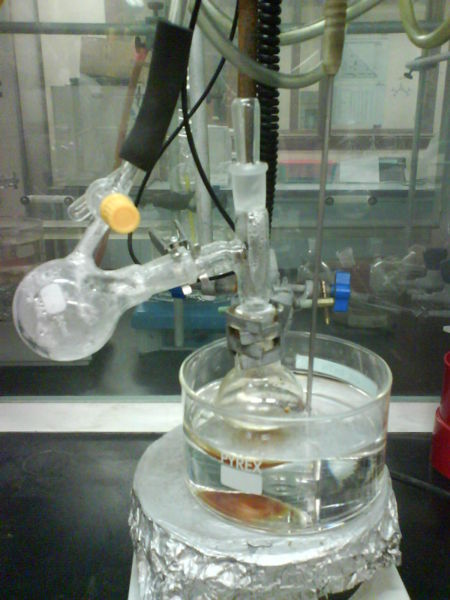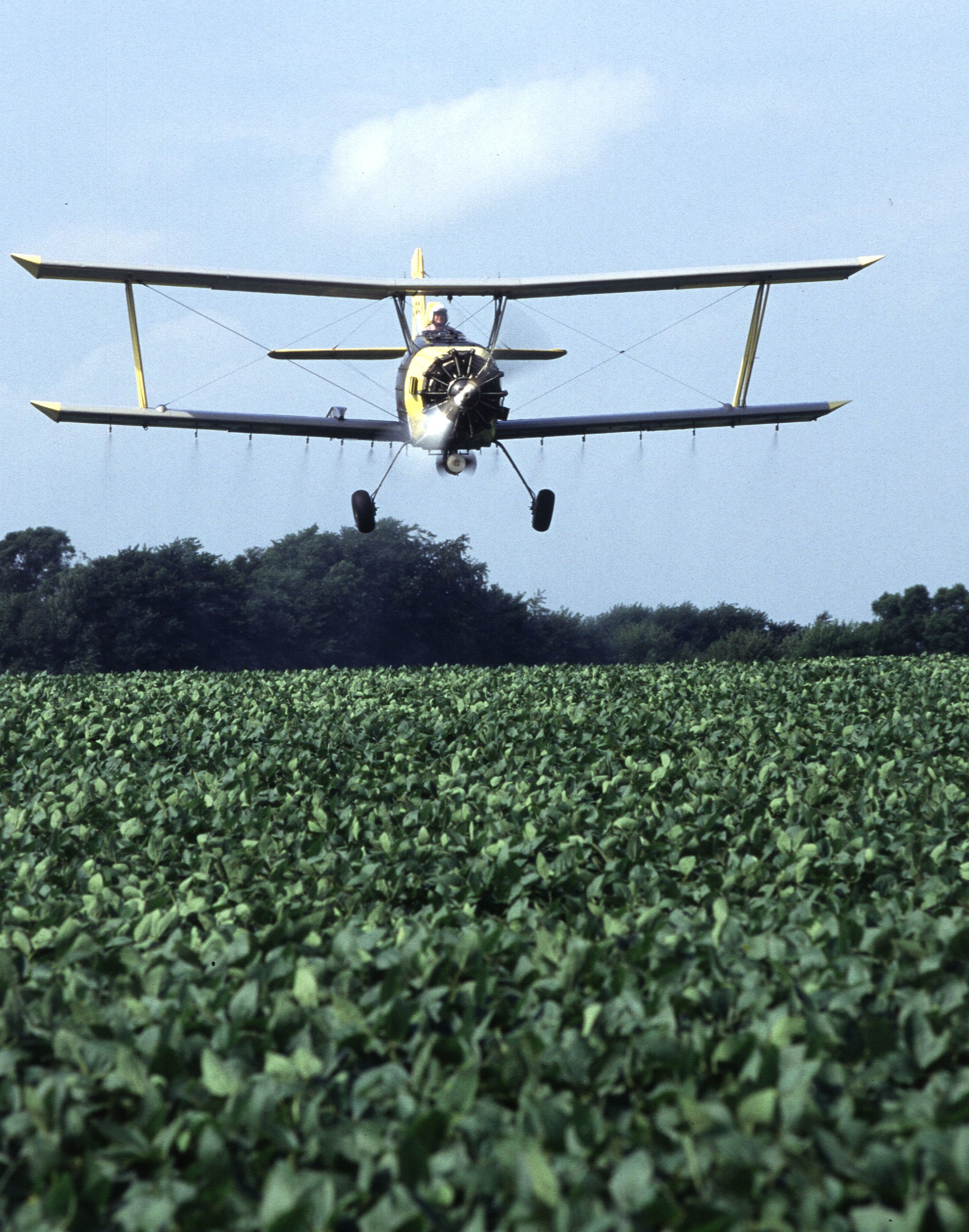|
Diflubenzuron
Diflubenzuron is an insecticide of the benzoylurea class. It is used in forest management and on field crops to selectively control insect pests, particularly forest tent caterpillar moths, boll weevils, gypsy moths, and other types of moths. It is a widely used larvicide in India for control of mosquito larvae by public health authorities. Diflubenzuron is approved by the WHO Pesticide Evaluation Scheme. Mechanism of action The mechanism of action of diflubenzuron involves inhibiting the production of chitin which is used by an insect to build its exoskeleton. It triggers insect larvae to molt early without a properly formed exoskeleton, resulting in the death of the larvae. Environmental toxicity Diflubenzuron has been evaluated by the United States Environmental Protection Agency (EPA), and it is classified as non-carcinogenic. 4-Chloroaniline, a metabolite of diflubenzuron which has been classified as a carcinogen, is produced after diflubenzuron has been ingested. Th ... [...More Info...] [...Related Items...] OR: [Wikipedia] [Google] [Baidu] |
Benzoylurea
Benzoylureas are chemical derivatives of ''N''-benzoyl-''N′''-phenylurea (benzoylurea). They are best known for their use as insecticides. They act as insect growth regulators by inhibiting synthesis of chitin in the insect's body. One of the more commonly used benzoylurea pesticides is diflubenzuron. Others include chlorfluazuron, flufenoxuron, hexaflumuron, and triflumuron. Lufenuron is the active compound in flea control medication for pet dogs and cats. 3-(Iodoacetamido)-benzoylurea (3-IAABU) is one of several benzoylurea compounds which have been investigated as potential anticancer agents. Environmental toxicity When applied in a dispersed way, for example through fumigation or spraying, these chemicals have an effect against a wide range of insect species, some of which may be beneficial to human activities, including crop-pollinators such as bees. In addition, as with many insecticides, application may result in the killing of natural predators or controls ... [...More Info...] [...Related Items...] OR: [Wikipedia] [Google] [Baidu] |
Fungus Gnat
Fungus gnats are small, dark, short-lived gnats, of the families Sciaridae, Diadocidiidae, Ditomyiidae, Keroplatidae, Bolitophilidae, and Mycetophilidae (order Diptera); they comprise six of the seven families placed in the superfamily Sciaroidea. Description The larvae of most species feed on fungi growing on soil, helping in the decomposition of organic matter. However some species are predatory, including those in the genus '' Arachnocampa'' of family Keroplatidae – the "glowworms" of Australia and New Zealand. The adults are long, and are occasionally pollinators of plants and carriers of mushroom spores. They also may carry diseases such as pythium (which causes " damping-off" to kill seedlings) on their feet. Most fungus gnats are weak fliers, and can often be seen walking rapidly over plants and soil, rather than flying. However when airborne, the gnats may be quite annoying to humans by flying into their faces, eyes, and noses, both indoors and outdoors. These ... [...More Info...] [...Related Items...] OR: [Wikipedia] [Google] [Baidu] |
Vigilante (insecticide)
Vigilante is an insecticide used with both dairy and beef cattle to reduce the number of flies in an agricultural area. It is usually formatted as a 50-gram bolus containing 9.7% diflubenzuron,Uniroyal ChemicalEPA product sheet for Vigilante 2001-09-27 an insect growth regulator which inhibits the formation of chitin and prevents insects from reproducing. The bolus is administered via balling gun. It is effective in reducing populations of horn flies and face flies for approximately 10–16 weeks. Vigilante was originally produced by American Cyanamid, and was the first larvicide marketed as a bolus. After the breakup of American Cyanamid, Vigilante was manufactured by Uniroyal Chemical and then by Chemtura. It is best used as part of an integrated pest management Integrated pest management (IPM), also known as integrated pest control (IPC) is a broad-based approach that integrates both chemical and non-chemical practices for economic control of pests. IPM aims to suppr ... [...More Info...] [...Related Items...] OR: [Wikipedia] [Google] [Baidu] |
Dimethyl Sulfoxide
Dimethyl sulfoxide (DMSO) is an organosulfur compound with the formula ( CH3)2. This colorless liquid is the sulfoxide most widely used commercially. It is an important polar aprotic solvent that dissolves both polar and nonpolar compounds and is miscible in a wide range of organic solvents as well as water. It has a relatively high boiling point. DMSO has the unusual property that many individuals perceive a garlic-like taste in the mouth after DMSO makes contact with their skin. In terms of chemical structure, the molecule has idealized Cs symmetry. It has a trigonal pyramidal molecular geometry consistent with other three-coordinate S(IV) compounds, with a nonbonded electron pair on the approximately tetrahedral sulfur atom. Synthesis and production Dimethyl sulfoxide was first synthesized in 1866 by the Russian scientist Alexander Zaytsev, who reported his findings in 1867. Dimethyl sulfoxide is produced industrially from dimethyl sulfide, a by-product of th ... [...More Info...] [...Related Items...] OR: [Wikipedia] [Google] [Baidu] |
Insect Control
Pest control is the regulation or management of a species defined as a pest; any animal, plant or fungus that impacts adversely on human activities or environment. The human response depends on the importance of the damage done and will range from tolerance, through deterrence and management, to attempts to completely eradicate the pest. Pest control measures may be performed as part of an integrated pest management strategy. In agriculture, pests are kept at bay by mechanical, cultural, chemical and biological means. Ploughing and cultivation of the soil before sowing mitigate the pest burden, and crop rotation helps to reduce the build-up of a certain pest species. Concern about environment means limiting the use of pesticides in favour of other methods. This can be achieved by monitoring the crop, only applying pesticides when necessary, and by growing varieties and crops which are resistant to pests. Where possible, biological means are used, encouraging the natural enemie ... [...More Info...] [...Related Items...] OR: [Wikipedia] [Google] [Baidu] |
Chlorobenzenes
Chlorobenzene is an aromatic organic compound with the chemical formula C6H5Cl. This colorless, flammable liquid is a common solvent and a widely used intermediate in the manufacture of other chemicals. Uses Historical The major use of chlorobenzene is as an intermediate in the production of herbicides, dyestuffs, and rubber. Chlorobenzene is also used as a high-boiling solvent in industrial applications as well as in the laboratory. Chlorobenzene is nitrated on a large scale to give a mixture of 2-nitrochlorobenzene and 4-nitrochlorobenzene, which are separated. These mononitrochlorobenzenes are converted to related 2-nitrophenol, 2-nitroanisole, bis(2-nitrophenyl)disulfide, and 2-nitroaniline by nucleophilic displacement of the chloride, with respectively sodium hydroxide, sodium methoxide, sodium disulfide, and ammonia. The conversions of the 4-nitro derivative are similar. Chlorobenzene once was used in the manufacture of pesticides, most notably DDT, by reaction ... [...More Info...] [...Related Items...] OR: [Wikipedia] [Google] [Baidu] |
Ureas
220 px, B_vitamins.html" ;"title="Biotin, a water-soluble B vitamins">B vitamin, is a urea. In chemistry, ureas are a class of organic compounds with the formula (R2N)2CO where R = H, alkyl, aryl, etc. Thus, in addition to describing the specific chemical compound urea ((H2N)2CO), urea is the name of a functional group that is found in many compounds and materials of both practical and theoretical interest. Generally ureas are colorless crystalline solids, which, owing to the presence of fewer hydrogen bonds, exhibit melting points lower than that of urea itself. Synthesis Ureas can be prepared many methods, but rarely by direct carbonation, which is the route to urea itself. Instead, methods can be classified according those that assemble the urea functionality and those that start with preformed urea. Assembly of N-substituted urea functionality Phosgenation entails the reaction of amines with phosgene Phosgene is the organic chemical compound with the formula COCl ... [...More Info...] [...Related Items...] OR: [Wikipedia] [Google] [Baidu] |
Benzamides
Benzamide is a organic compound with the chemical formula of C6H5C(O)NH2. It is the simplest amide derivative of benzoic acid. In powdered form, it appears as a white solid, while in crystalline form, it appears as colourless crystals. It is slightly soluble in water, and soluble in many organic solvents. It is a natural alkaloid found in the herbs of Berberis pruinosa. Chemical derivatives A number of substituted A substitution reaction (also known as single displacement reaction or single substitution reaction) is a chemical reaction during which one functional group in a chemical compound is replaced by another functional group. Substitution reactions ar ... benzamides are commercial drugs, including: See also * References External links Physical characteristics {{Authority control Phenyl compounds ... [...More Info...] [...Related Items...] OR: [Wikipedia] [Google] [Baidu] |
Insecticides
Insecticides are substances used to kill insects. They include ovicides and larvicides used against insect eggs and larvae, respectively. Insecticides are used in agriculture, medicine, industry and by consumers. Insecticides are claimed to be a major factor behind the increase in the 20th-century's agricultural productivity. Nearly all insecticides have the potential to significantly alter ecosystems; many are toxic to humans and/or animals; some become concentrated as they spread along the food chain. Insecticides can be classified into two major groups: systemic insecticides, which have residual or long term activity; and contact insecticides, which have no residual activity. The mode of action describes how the pesticide kills or inactivates a pest. It provides another way of classifying insecticides. Mode of action can be important in understanding whether an insecticide will be toxic to unrelated species, such as fish, birds and mammals. Insecticides may be repelle ... [...More Info...] [...Related Items...] OR: [Wikipedia] [Google] [Baidu] |
Bolus (medicine)
In medicine, a bolus (from Latin ''bolus'', ball) is the administration of a discrete amount of medication, drug, or other compound within a specific time, generally 1–30 minutes, to raise its concentration in blood to an effective level. The administration can be given by injection: intravenously, intramuscularly, intrathecally, subcutaneously, or by inhalation. The article on routes of administration provides more information, as the preceding list of ROAs is not exhaustive. Placement The placement of the bolus dose depends on the systemic levels of the contents desired throughout the body. An intramuscular injection of vaccines allows for a slow release of the antigen to stimulate the body's immune system and to allow time for developing antibodies. Subcutaneous injections are used by heroin addicts (called 'skin popping', referring to the bump formed by the bolus of heroin), to sustain a slow release that staves off withdrawal symptoms without producing euphoria. ... [...More Info...] [...Related Items...] OR: [Wikipedia] [Google] [Baidu] |
Begonia
''Begonia'' is a genus of perennial flowering plants in the family Begoniaceae. The genus contains more than 2,000 different plant species. The Begonias are native to moist subtropical and tropical climates. Some species are commonly grown indoors as ornamental houseplants in cooler climates. In cooler climates some species are cultivated outside in summertime for their bright colorful flowers, which have sepals but no petals. Description With 2,002 species, ''Begonia'' is one of the largest genera of flowering plants. The species are terrestrial (sometimes epiphytic) herbs or undershrubs, and occur in subtropical and tropical moist climates, in South and Central America, Africa, and southern Asia. Terrestrial species in the wild are commonly upright- stemmed, rhizomatous, or tuberous. The plants are monoecious, with unisexual male and female flowers occurring separately on the same plant; the male contains numerous stamens, and the female has a large inferior ovary and ... [...More Info...] [...Related Items...] OR: [Wikipedia] [Google] [Baidu] |




